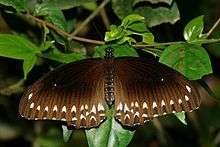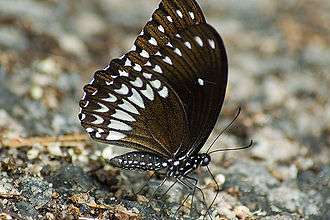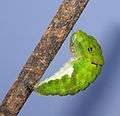Papilio dravidarum
| Malabar raven | |
|---|---|
 | |
| At Kadavoor, Kerala, India | |
| Scientific classification | |
| Kingdom: | Animalia |
| Phylum: | Arthropoda |
| Class: | Insecta |
| Order: | Lepidoptera |
| Family: | Papilionidae |
| Genus: | Papilio |
| Species: | P. dravidarum |
| Binomial name | |
| Papilio dravidarum Wood-Mason, 1880 | |
| Synonyms | |
|
Princeps dravidarum | |
Papilio dravidarum, the Malabar raven, is an endemic species of swallowtail butterfly found in the Western Ghats of India.
Description

The Malabar raven is a blackish-brown tailless swallowtail, about 80 to 100 mm in size. Both the sexes are similar and are mimics of the unpalatable common crow (Euploea core). The upper forewing has a small white spot at the end of the cell, a complete series of equal sized marginal white spots in regular row and a terminal series of spots decreasing in size towards the apex. The upper hindwing has a discal series of arrow shaped white spots. It also has a submarginal series of elongated white crescent shaped markings. There is a white fringe between the veins. The outer halves of wings have a dusting of yellowish brown scales.
Range
It is endemic to the Western Ghats in South India where it occurs in the states of Kerala, Tamil Nadu, Karnataka and Goa.
Status
The butterfly is uncommon but not known to be threatened. It was commonest in Wynaad and Coorg in the past and rarer towards the extremities of its range.
Habitat
This butterfly frequents heavy jungles of the Western Ghats between 1,000 and 3,000 feet (300 and 910 m). It has been recorded in January and from March to October.
Habits

The Malabar raven resembles the model common crow in habits and flight, but is faster than the other mimic, the common mime. It prefers shady patches. The males drink at wet patches especially in the hot dry pre-monsoon days. This butterfly does not visit flowers.
Life cycle
There are two to three broods a year. It is recorded in Coorg as having broods from September to October, November to December, and, from April to May. It has been recorded in Karnataka in July and in September. Males appear to outnumber the females.
 Caterpillar
Caterpillar Caterpillar pupating
Caterpillar pupating Pupa
Pupa
Food plants
- Glycosmis pentaphylla of the family Rutaceae. Others that have been noted include Clausena heptaphylla.[1]
Systematics
Papilio dravidarum is a member of the castor species group. The clade members are:
- Papilio castor Westwood, 1842
- Papilio dravidarum Wood-Mason, 1880
- Papilio mahadeva Moore, [1879]
See also
References
- ↑ Kunte, K. 2006. Additions to known larval host plants of Indian butterflies. Journal of the Bombay Natural History Society 103(1):119-120
Other sources
- Collins, N. Mark; Morris, Michael G. (1985). Threatened Swallowtail Butterflies of the World: The IUCN Red Data Book. Gland & Cambridge: IUCN. ISBN 978-2-88032-603-6.
- Evans, W.H. (1932). The Identification of Indian Butterflies (2nd ed.). Mumbai, India: Bombay Natural History Society.
- Gaonkar, Harish (1996). Butterflies of the Western Ghats, India (including Sri Lanka) - A Biodiversity Assessment of a Threatened Mountain System. Bangalore, India: Centre for Ecological Sciences.
- Gay, Thomas; Kehimkar, Isaac David; Punetha, Jagdish Chandra (1992). Common Butterflies of India. Nature Guides. Bombay, India: World Wide Fund for Nature-India by Oxford University Press. ISBN 978-0195631647.
- Kunte, Krushnamegh (2000). Butterflies of Peninsular India. India, A Lifescape. Hyderabad, India: Universities Press. ISBN 978-8173713545.
- Wynter-Blyth, Mark Alexander (1957). Butterflies of the Indian Region. Bombay, India: Bombay Natural History Society. ISBN 978-8170192329.
External links
- Butterfly Corner Images from Naturhistorisches Museum Wien